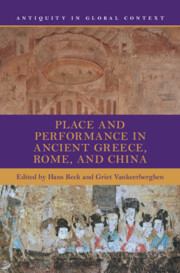Book contents
- Place and Performance in Ancient Greece, Rome, and China
- Antiquity in Global Context
- Place and Performance in Ancient Greece, Rome, and China
- Copyright page
- Contents
- Figures
- Tables
- Contributors
- Series Editors’ Preface
- Editors’ Preface
- Introduction
- Part I Crafting Space and Place
- Part II Performances of Power
- Part III Urban Places
- Chapter 7 Neighborhood Life in Imperial Rome and Han Chang’an
- Chapter 8 Society, Cities, and the Significance of ‘Sacred Roads’ in Archaic Greece, in the Chinese Qin and Han Empires, and in the Archaic States of the Middle East
- Chapter 9 Hydropolitical Engineering in Rome and Chang’an
- Chapter 10 Imperial Gardens in Early Roman and Chinese Empires
- Part IV Fringe Places and Endpoints
- Index
- References
Chapter 8 - Society, Cities, and the Significance of ‘Sacred Roads’ in Archaic Greece, in the Chinese Qin and Han Empires, and in the Archaic States of the Middle East
from Part III - Urban Places
Published online by Cambridge University Press: 28 November 2024
- Place and Performance in Ancient Greece, Rome, and China
- Antiquity in Global Context
- Place and Performance in Ancient Greece, Rome, and China
- Copyright page
- Contents
- Figures
- Tables
- Contributors
- Series Editors’ Preface
- Editors’ Preface
- Introduction
- Part I Crafting Space and Place
- Part II Performances of Power
- Part III Urban Places
- Chapter 7 Neighborhood Life in Imperial Rome and Han Chang’an
- Chapter 8 Society, Cities, and the Significance of ‘Sacred Roads’ in Archaic Greece, in the Chinese Qin and Han Empires, and in the Archaic States of the Middle East
- Chapter 9 Hydropolitical Engineering in Rome and Chang’an
- Chapter 10 Imperial Gardens in Early Roman and Chinese Empires
- Part IV Fringe Places and Endpoints
- Index
- References
Summary
Martin Mohr’s chapter extends issues of urban space and infrastructure to the critical theme of Sacred Roads. It thus complements the chapters on neighborhoods, water supplies, and public gardens. Within the city and beyond its urban environment, roads have been both a facilitator of mobility and a conveyor of meaning at all times and in all cultures. Acknowledging the fundamental difference in the basic configuration of ancient Greek and Qin and Han Chinese societies, Mohr’s exploration of the significance of monumental roads emanates from the careful crafting of a meaningful matrix of comparison. He finds this in the typology of ancient societies as modelled in the works of Christoph Ulf; although tied to observations in the ancient Mediterranean, Mohr explains how the model is applicable to ancient worlds in general. Reliance on bureaucratic structures and techniques set Chinese building projects apart from the notoriously small scale of Greek roads. The question of physical disproportions set apart – note how Chang’an contained a monumental grid of multi-lane passage fares – the chapter demonstrates how the Direct Road, from Yunyang to Jiuyuan, was the religious and topographical backbone of Chinese society, much like sacred procession roads in ancient Greece, for instance on the island of Samos. In both cases, the purpose of reinforcing central strategies to establish physical connections between political and religious centres went hand in hand with the goal of achieving societal cohesion. The comparison concludes with further insight into regions between China and the Mediterranean, whose monumentally and ideologically inflated palatial cities once again accentuated an intriguing foil for the Greek example.
Keywords
- Type
- Chapter
- Information
- Place and Performance in Ancient Greece, Rome, and China , pp. 274 - 296Publisher: Cambridge University PressPrint publication year: 2024

